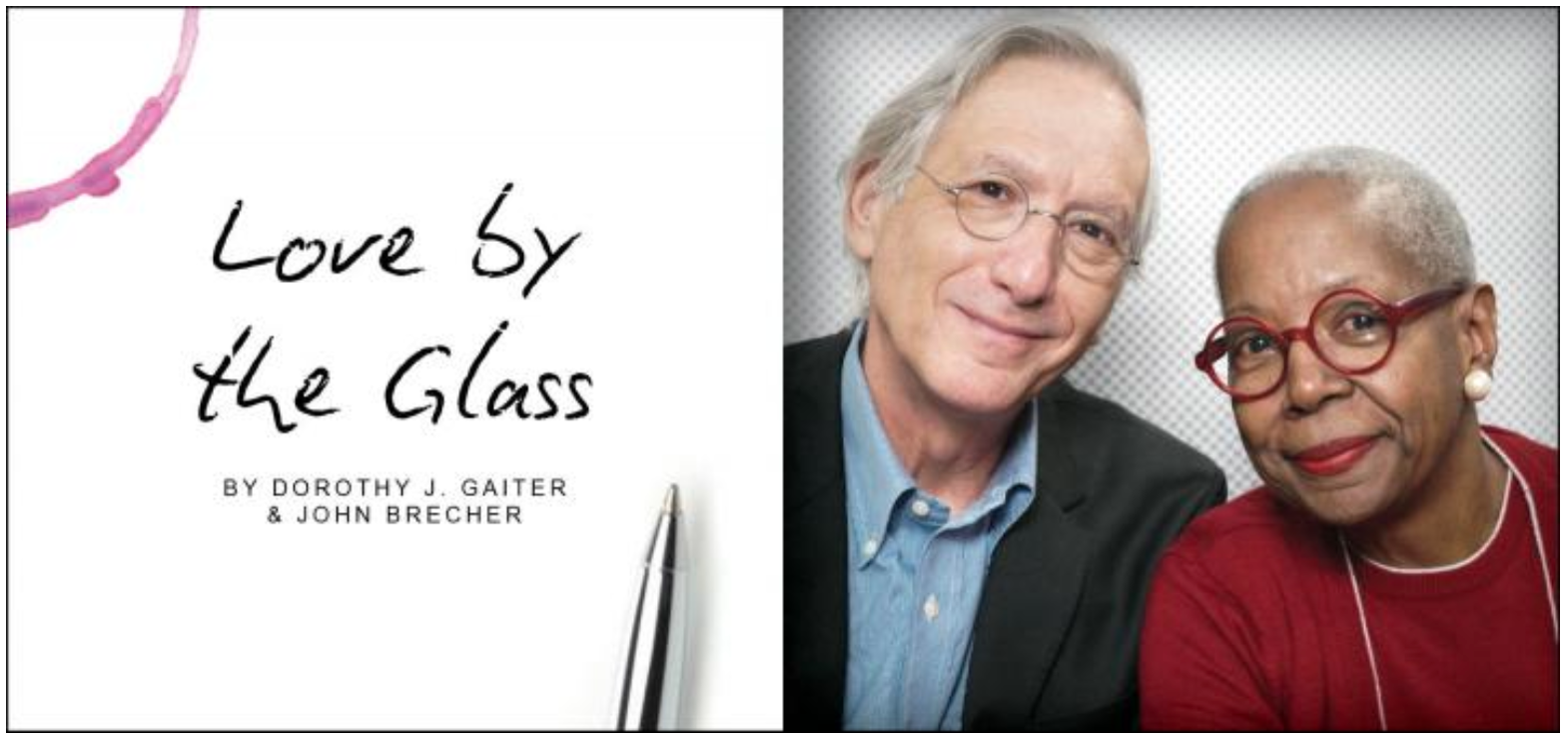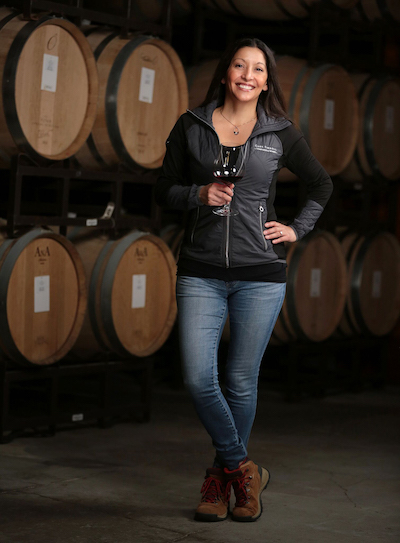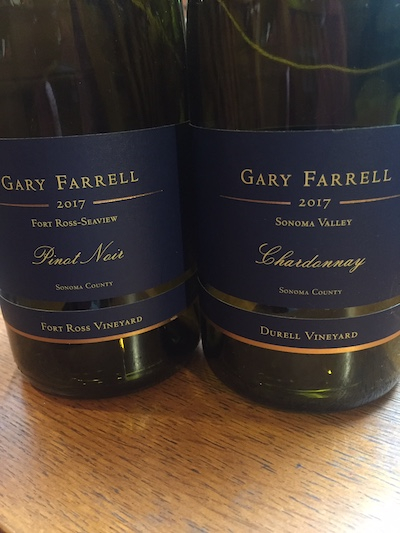
Wineries all over California bear the name of someone who sold the brand – and hence their own name – long ago. Sometimes that doesn’t work out so well. In 1986, we had an excellent Gamay from Charles Shaw, whose name was later bought and is now better known as Two-Buck Chuck. Sometimes it works out fine. Almost 20 years ago, Gary Farrell sold his pioneering winery in the Russian River Valley and it continues to produce outstanding, site-specific Pinot Noir and Chardonnay. Much of that success can be attributed to Theresa Heredia, the winemaker since 2012, and to a management team that simply wanted the best person for the job – and found a third-generation Mexican-American woman at a time when, even more than now, there were not many winemakers who were either.
 Gary Farrell Vineyards and Winery made stunning Chardonnay and Pinot Noir from great vineyards and that is still the case – names like Rochioli, Sanford & Benedict, Bien Nacido, Durell and Fort Ross. And Heredia, 50, like many winemakers, tries to give all the credit to those awesome vineyards: “If you’re choosing to work with the best sites possible, my goal as a winemaker is to -- pardon my French -- not f--- it up.” But when we called Heredia recently, we were reminded that, while great wines start in the vineyard, they ultimately also express the soul of the winemaker, who must make about a million decisions, big and small, that ultimately determine how that wine tastes. In Heredia’s case, it all comes back to bananas and peaches.
Gary Farrell Vineyards and Winery made stunning Chardonnay and Pinot Noir from great vineyards and that is still the case – names like Rochioli, Sanford & Benedict, Bien Nacido, Durell and Fort Ross. And Heredia, 50, like many winemakers, tries to give all the credit to those awesome vineyards: “If you’re choosing to work with the best sites possible, my goal as a winemaker is to -- pardon my French -- not f--- it up.” But when we called Heredia recently, we were reminded that, while great wines start in the vineyard, they ultimately also express the soul of the winemaker, who must make about a million decisions, big and small, that ultimately determine how that wine tastes. In Heredia’s case, it all comes back to bananas and peaches.
We have been Gary Farrell fans for a very long time. In 1987, during a visit to Sonoma, we ate at a restaurant in Santa Rosa and ordered a wine we’d never seen before, Gary Farrell Pinot Noir. We loved it. The next day, we wandered into a tasting room for another winery we’d never heard of, called Rochioli. We tasted their Pinot and remarked that it reminded us of a delicious Pinot we’d had the night before called Gary Farrell. The woman behind the counter said that’s no surprise since he was the consulting winemaker for this wine and that his full-time job was as winemaker at Davis Bynum, right up the road. We rushed off to meet him just in time to shake his hand as he was getting into his car to leave.
Gary Farrell and Rochioli Vineyards and Winery both soon became quite famous. Davis Bynum has had a big impact, too, but in a different way. Around the time we were there, it had a low-priced wine called Barefoot Bynum. Gallo later bought Barefoot, which is now, by far, the best-selling brand in the U.S.
Gary Farrell sold his winery to giant Allied Domecq in 2004 and it went through some ownership changes after that (Farrell was winemaker until 2006 and has had no formal involvement since then). Heredia, who was born in California, studied at the University of California at Davis. She had been in the chemistry PhD program when she switched to enology and then headed off to start making wine. Hired by Joseph Phelps Vineyards as a research chemist, she was promoted to associate winemaker for Phelps’s Freestone label in 2005, spent a harvest in Burgundy in 2006 and became winemaker at Freestone in 2008.
In 2011, a group of investors called Vincraft, led by winery executive and businessman Bill Price, bought Gary Farrell and were looking for a new winemaker. (Vincraft became WineCo in 2015 and Price remains the lead investor.) They turned the hunt over to Nancy Bailey, then and now the general manager of the winery. “My focus was on finding somebody who not only was an incredible winemaker, but was making wines in a style that was Gary Farrell-esque,” Bailey told us. “We wanted to respect the history and tradition, but also somebody who could perhaps take us to a new level. I was also looking for somebody who would be able to go on the road with me and would be able to talk with consumers, trade and media at whatever level people came to them. Some winemakers are fabulous winemakers but not so good at explaining what it is that they do.”
Bailey spent a great deal of time talking with people and searching the Internet and then, one day, she heard Heredia on a radio show talking about biodynamics. Bailey knew right away that Heredia was the right person to be both winemaker and ambassador for the brand.
 If you ever get a chance to hear Heredia speak – in addition to tasting the wines, of course – you will know Bailey made a wise choice. Her passion for the wines and the vineyards is obvious, but what also makes her special is her ability to explain her winemaking choices in language that is both sophisticated and understandable.
If you ever get a chance to hear Heredia speak – in addition to tasting the wines, of course – you will know Bailey made a wise choice. Her passion for the wines and the vineyards is obvious, but what also makes her special is her ability to explain her winemaking choices in language that is both sophisticated and understandable.
(Our first Gary Farrell, drunk in 1987)
We asked her, for instance, how Gary Farrell’s wines are the same and how they are different from when he made them.
“The style, the final product, stylistically, I think we have very similar philosophies,” she said. “The goal is to make wines that are food-friendly, with a great acid backbone, wines that have fresh, vibrant aromas and most importantly are expressive of the place because his philosophy from the beginning was always to work with the iconic vineyards around Sonoma County. Coming in, that’s what my goal was and it still is.
“The funny thing is, though, I’m doing almost everything just a little bit differently than what Gary would do back in the day.” She went through a long list of examples: picking earlier, using barrels that have been more lightly toasted, racking less, using some whole-cluster fermentation.
And, by the way, she has never met Gary Farrell, the actual person. But Bailey keeps in touch. The GM said even through all of the ownership changes, “we were infected by the ‘what would Gary Farrell do?’ spirit.
“One of the things I always have in the back of my mind is making him proud of this brand that he birthed,” Bailey said, adding: “I would say there is no greater compliment to Theresa than that Gary several years back actually started buying the wines for himself and for his friends and family.”

We asked her if she’d consider it a compliment that we found her Chardonnays Chablis-like in their focus, acidity and sense of place. (Our very favorite: Durell Vineyard 2017, $65). She said yes, so we asked her how she accomplished that. Listen in:
“I like to pick on the earlier end of the ripeness spectrum. And when you pick earlier you capture these really vibrant, fresh aromatics, more floral and mineral and citrus as opposed to riper golden fruit like ripe apples, ripe pears, tropical fruit, pineapple – those aren’t the qualities I’m looking for.
“When I eat bananas or I eat peaches or nectarines, I don’t like to eat fruit when they are softening and beginning to get overripe. I like them when they’re fresh. Bananas, as soon as they get spots, I don’t like to eat them anymore because they don’t have that fresh vibrant flavor anymore and they don’t have as much tangy acidity.
“When you are picking earlier, as the sugar increases, acid decreases, so the earlier you pick, capturing those vibrant flavors, the more natural acidity you capture.”
She also keeps the juice with what she calls the “fluffy” lees (winemaking sediment like dead yeast from fermentation) for longer than many. All of this, she said, is in service of the vineyard: “It helps to accentuate the sense of place, the expression of each of the beautiful vineyards, because the more grape material you put into the fermentation the more expression of place you get and that’s my number one priority.”
We also asked about the Fort Ross Vineyard Pinot Noir, which impressed us tremendously (2017, $75). We found it to be a profound wine, rich without being heavy, with real stature. We had told her earlier in the conversation that we didn’t want her to give all of the credit to any site because clearly she wasn’t just a bystander, so she began her response this way: “You’re not going to like this answer, but a lot of it is the site.
“It is 1,400 feet above the ocean. So it’s bathed in the fog in the morning but by late morning the vineyard is sitting well above the fog and you can look down and it’s like an ocean of fog right below you. So the grapes are in that very cool climate but with exposure to the sun for most of the day. You get this richness and this opulence to the wine but it’s not over the top, so the wine because of the cool temperatures has this great acid backbone to it, nice minerality and nice savory qualities. It has this great balance to it but because of the climate and the elevation and the clonal materials you get that expression of intensity and richness without being overboard.”
We first made contact with Heredia a couple of months ago after Dottie wrote a piece for SevenFifty Daily called “Being Black in the White World of Wine.” Heredia contacted us to say that as a Mexican-American woman winemaker who identifies as LGBTQ, she knows change has to come and she hopes to have a series of panel discussions to ask how to dismantle racism in the wine industry.
At the winery in 2016, Heredia married her wife, a therapist who works with sexually abused women. The winemaker said Sonoma is very gay-friendly, but, like most wine regions, has a long way to go to become race-friendly as well. We asked her how that could happen.
“We as human beings accept what’s around us, what we see, the people we talk to. It’s about exposure,” she said. “Sonoma County for many years has been very gay-friendly because we have all these gay folks coming from San Francisco. We’ve seen them. We’ve spoken to them. We’re friends with them.”
But there are not that many visitors or residents of color. “We have to be surrounded by people of color, we have to get to know them and we need to understand their differences and people have to stop saying that they don’t see color. They have to accept cultural differences. We’re all different from one another so let’s talk to each other and get to know each other.”
She said even small steps are important, like making Sonoma County’s tourism materials more diverse so everyone knows they are welcome. The issue of tourism is one of the panels she hopes to host when they get under way, probably after harvest.
“We need to think about the experiences we are offering to people,” she said. “Do we have something that’s very fun and welcoming to newcomers? I think that the more approachable we make our wine-tasting experiences at the winery the more millennials we’re going to get, the more diversity we’re going to get and actually I think the more diversity you bring to your winery, it is going to bring millennials. That’s a big issue that people talk about, like ‘How do we get the millennials?’ Well, they want to see diversity and inclusion.”
Her basic point, we agreed, was this: Diversity builds on diversity. And the sooner you take the first steps, the better.
Dorothy J. Gaiter and John Brecher conceived and wrote The Wall Street Journal's wine column, "Tastings," from 1998 to 2010. Dorothy and John have been tasting and studying wine since 1973. In 2020, the University of California at Davis added their papers to the Warren Winiarski Wine Writers Collection in its library, which also includes the work of Hugh Johnson and Jancis Robinson. Dottie has had a distinguished career in journalism as a reporter, editor, columnist and editorial writer at The Miami Herald, The New York Times, and at The Journal. John was Page One Editor of The Journal, City Editor of The Miami Herald and a senior editor at Bloomberg News. They are well-known from their books and many television appearances, especially on Martha Stewart's show, and as the creators of the annual, international "Open That Bottle Night" celebration of wine and friendship. The first bottle they shared was André Cold Duck. They have two daughters.
Banner art by Piers Parlett










